Method of thin film epitaxial growth using atomic layer deposition
a thin film and atomic layer technology, applied in the direction of crystal growth process, chemically reactive gas, coating, etc., can solve the problems of high consumption of deposition precursors, difficult pulsing of molecular precursors to uniformly fill high aspect ratio features on the substrate in a short time, and inconvenient ald process for epitaxial growth
- Summary
- Abstract
- Description
- Claims
- Application Information
AI Technical Summary
Benefits of technology
Problems solved by technology
Method used
Image
Examples
Embodiment Construction
[0015]Referring to FIG. 1, FIG. 1 is a schematic diagram of an atomic layer deposition (ALD) apparatus. As shown in FIG. 1, the ALD apparatus comprises an inert gas supply 7, a chamber 8, a vacuum pump 10, a first deposition precursor supply 1, a second deposition precursor supply 2, a vent valve 9, four two-port solenoid valves 3, 4, 5, 6 and a manifold 11 having two inlets and one outlet. A first deposition precursor and a second deposition precursor is contained in the first deposition precursor supply 1 and the second deposition precursor supply 2 respectively. The vent valve 9 is connected between the chamber 8 and the vacuum pump 10 for the vacuum pump 10 to vacuum the chamber 8 or remove gaseous species (e.g. unreacted precursor, reaction products, etc.).
[0016]The two-port solenoid valve 3 is connected between the first deposition precursor supply 1 and one inlet of the manifold 11; the two-port solenoid valve 5 is connected between the second deposition precursor supply 2 an...
PUM
| Property | Measurement | Unit |
|---|---|---|
| pressure | aaaaa | aaaaa |
| pressure | aaaaa | aaaaa |
| temperature | aaaaa | aaaaa |
Abstract
Description
Claims
Application Information
 Login to View More
Login to View More - R&D
- Intellectual Property
- Life Sciences
- Materials
- Tech Scout
- Unparalleled Data Quality
- Higher Quality Content
- 60% Fewer Hallucinations
Browse by: Latest US Patents, China's latest patents, Technical Efficacy Thesaurus, Application Domain, Technology Topic, Popular Technical Reports.
© 2025 PatSnap. All rights reserved.Legal|Privacy policy|Modern Slavery Act Transparency Statement|Sitemap|About US| Contact US: help@patsnap.com



